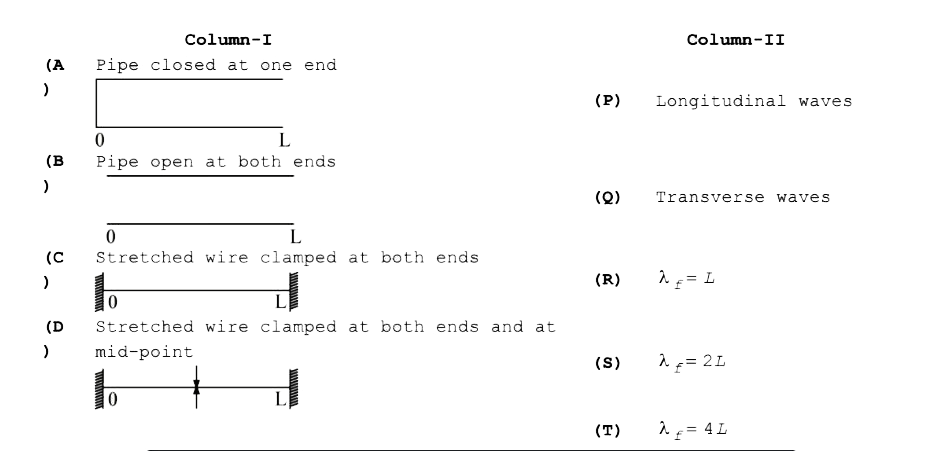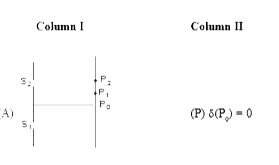Column I shows four systems, each of the same length L, for producing standing waves. The lowest possible natural frequency of a system is called it fundamental frequency, whose wavelength is denoted as λt. Match each system with statements given in Column II describing the nature and wavelength of the standing waves.

The correct Answer is:A→(p,t) B→(p,s) C→(q,s) D→(q,r)
In case of pipe we can produce longitudinal waves and for strings we produce transverse waves.
A→(p,t) : It is a closed organ pipe hence in case of fundamental vibrations length of the tube must be (14)th of the wavelength (half loop).
λt4=L⇒λt=4L
B→(p,s) : It is open organ pipe hence in case of fundamental vibrations length of the pipe must be half of the wavelength (one loop).
λt2=L⇒λt=2L
C→(q,s) : It is a case of string of length L fixed at both ends. In case of fundamental vibrations length of the pipe must be half of the wavelength (one loop).
λt2=L⇒λt=2L
D→(q,r) : In this case mid-point is fixed hence half-length must form one loop.
λt2=L2⇒λt=L
Topper's Solved these Questions
- WAVESBOOK - MODERN PUBLICATIONCHAPTER - WAVESEXERCISE - INTEGER TYPE QUESTION
13 Videos
- WAVESBOOK - MODERN PUBLICATIONCHAPTER - WAVESEXERCISE - CHAPTER PRACTICE TEST
14 Videos
- WAVESBOOK - MODERN PUBLICATIONCHAPTER - WAVESEXERCISE - MATCHING TYPE QUESTIONS
3 Videos
- UNITS AND MEASUREMENTBOOK - MODERN PUBLICATIONCHAPTER - UNITS AND MEASUREMENTEXERCISE - CHAPTER PRACTICE TEST
15 Videos
- WORK, ENERGY AND POWER BOOK - MODERN PUBLICATIONCHAPTER - WORK, ENERGY AND POWER EXERCISE - Chapter Practice Test
16 Videos
Similar Questions
Natural frequency of a system is called its fundamental frequency, whose wavelength is denoted as λf. Match each system with statements given in Column-II describing the nature and wavelength of the standing waves.

View SolutionNatural frequency of a system is called its fundamental frequency, whose wavelength is denoted as λf. Match each system with statements given in Column-II describing the nature and wavelength of the standing waves.

View Solution
Knowledge Check
Column I shows four situations of standard Young’s double slit arrangement with the screen placed far away from the slits S1 and S2 . In each of these cases S1P0=S2P0,S1P1−S2P1=λ/4 and S1P2−S2P2=λ/3, where λ is the wavelength of the light used. In the cases B,C and D, a transparent sheet of refractive index μ and thickness t is pasted on slit S1 . The thicknesses of the sheets are different in different cases. The phase difference between the light waves reaching a point P on the screen from the two slits is denoted by δ(P) and the intensity by I(P). Match each situation given in Column I with the statement(s) in Column II valid for that situation.
A B
B C
C D
D
Standing waves are produced by the interference of two traveling sinusoidal waves, each of frequency 100 Hz. The distance from the 2nd node to the 5th node is 60 cm. The wavelength of each of the two original waves is
A50cmB40cmC30cmD20cm
Column I shows four systems, each of the same length L, for producing waves. The lowest possible natural frequency of a system is called its fundamental frequency, whose wavelength is denoted as λf. Match each system with statements given in Column II describing the nature and wavelength of the standing waves.

View SolutionColumn I shows four systems, each of the same length L, for producing waves. The lowest possible natural frequency of a system is called its fundamental frequency, whose wavelength is denoted as λf. Match each system with statements given in Column II describing the nature and wavelength of the standing waves.

View SolutionA standing wave is set up in a string of a variable length and tension by a vibrator of variable frequency . Both ends of the string are fixed . When the vibrator has a frequency f , in a string of length L and under tension T,n antinodes are set up in the string is doubled , by what factor should the frequency be changed so that the same number of antinodes is produced? (b) If the frequency and lenght are held constant , what tension will produce n+1 antinodes ? ( c) If the frequency is tripled and the length of the string is halved , by what factor should the tension be changed so that twice as many antinodes are produced ?
View SolutionA snapshot of a travelling wave is shown in figure- 1 and a snapshot of a standing wave is shown in figure-2.(Particles are at their respective extremes.The amplitude, frequency, and the speed of both the waves are the same.The string in both the cases is identical). If the energy per unit length of system at point A in figure- 1 ,is x1 and that in figure- 2 is x2 .What is value of X1x2
View SolutionFigure 16-37 shows resonane oscillation of a string of mass m=2.500 g and lengt L= 0.800 m and that is under tension τ=325.0N. What is the wavelength λ of the transverse waves producing the standing wave patient and what is the charmant number. What is the frequency of the transverst waves and of the osciallation of the moving string elements? What is the maximum magnitude of the transverse velocity um of the element oscillating a coordinate x =0.180 m? At what point during the element's oscillation is the transverse velocity maximum?
View SolutionTwo wires each carrying a steady current I are shown in four configurations in Column I. Some of the resulting effects are described in Column II. Match the statements in Column I with the statements in Column II and the indicate your answer by darkening appropriate bubbles in the 4×4 matrix given in the ORS.

View Solution
